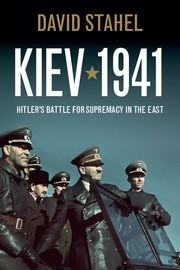Book contents
- Frontmatter
- Contents
- Figures
- Tables
- Maps
- Acknowledgements
- Glossary of terms
- Tables of military ranks and army structures
- Introduction
- 1 The bulldog, the eagle and the bear
- 2 Germany's defeat in the east
- 3 The road to Kiev
- 4 War in the Ukraine
- 5 Ominous horizons
- 6 The battle of Kiev
- 7 Slaughter in the Ukraine
- 8 Visions of victory
- 9 The calm before the storm
- 10 Moscow in the crosshairs
- Conclusion
- Notes
- Bibliography
- Index
8 - Visions of victory
Published online by Cambridge University Press: 05 November 2011
- Frontmatter
- Contents
- Figures
- Tables
- Maps
- Acknowledgements
- Glossary of terms
- Tables of military ranks and army structures
- Introduction
- 1 The bulldog, the eagle and the bear
- 2 Germany's defeat in the east
- 3 The road to Kiev
- 4 War in the Ukraine
- 5 Ominous horizons
- 6 The battle of Kiev
- 7 Slaughter in the Ukraine
- 8 Visions of victory
- 9 The calm before the storm
- 10 Moscow in the crosshairs
- Conclusion
- Notes
- Bibliography
- Index
Summary
Circling the wagons – the siege of Leningrad begins
While the battle of Kiev proceeded with the bulk of Army Group Centre and Army Group South's motorized forces, it was not the only German offensive under way in September. The thrust towards Leningrad had earlier attained precedence over Moscow as one of the supposedly decisive objectives in deciding the eastern campaign. Yet, just as the battle of Kiev was not the effortless blitzkrieg sometimes portrayed, so too achieving the blockade of Leningrad was no pushover. Indeed much of the historical argument about whether the Germans should have pressed for the capture of Leningrad in September 1941 seems devoid of an understanding of the difficulties involved, which had to be considered on top of what the two and a half month drive to the city had cost Army Group North. The difficulties of Guderian's long drive to Romny or Kleist's far-flung battle at Dnepropetrovsk were by no means exceptional, and with Hoepner's Panzer Group 4 assigned a vital role in Operation Typhoon, its condition by the end of September was vital to Bock's much anticipated success.
Leeb's underresourced Army Group North had been struggling to reach Leningrad since the beginning of the campaign. After advancing 450 kilometres in only the first two weeks of the campaign, there seemed little doubt that the remaining 250 kilometres to Leningrad could be covered in a roughly similar time. Yet the same problems hampering operations further south also plagued Leeb's advance. Roads, when available, were potholed and sandy, there were not enough forces to fill the expanding area of operations, supplies at the spearheads ran short, combat losses mounted and Soviet resistance stiffened. Already by early July Leeb's army group was overextended. After the rapid gains of the first two weeks the next month of operations saw an advance of only 120 kilometres. Even so Leeb's forces had to be propped up by the transfer of major units from Army Group Centre. Colonel-General Wolfram von Richthofen's VIII Air Corps was dispatched at the end of July and that was followed by General of Panzer Troops Rudolf Schmidt's XXXIX Panzer Corps in mid-August. Only with such strong reinforcements could Leeb's army group penetrate successive Soviet defensive lines and continue closing in on Leningrad. Nevertheless the fighting was taking its toll on the combat units, for which there were not enough replacements to keep pace with losses. At the beginning of August Army Group North had already sustained 42,000 casualties, but received only 14,000 replacements. Nor did the situation improve, and by the end of the month Leeb wrote in his diary, ‘Unfortunately the replacement situation reveals itself to be more and more catastrophic’. For those who had survived the fighting unscathed the strain was becoming all too apparent. Albert Neuhaus wrote home on 20 August, ‘The first four weeks of the advance seemed to us almost like a Strength through Joy trip, until we arrived up here and met horrendous resistance. And what the next four weeks meant for us only we know, we who have experienced it…I was a few days at the end of my nerves, so that my heart was in my throat when I only heard a grenade whistle.’
- Type
- Chapter
- Information
- Kiev 1941Hitler's Battle for Supremacy in the East, pp. 274 - 302Publisher: Cambridge University PressPrint publication year: 2011



